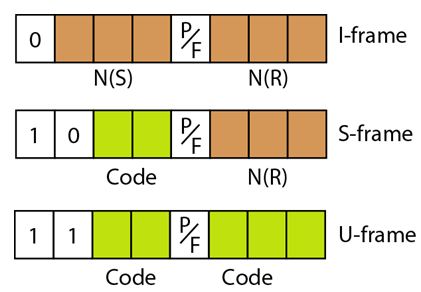Control Fields of HDLC Frames:
The control field determines the type of frame and defines its functionality. So let us discuss the format of this field in greater detail. The format is specific for the type of frame, as shown in the following figure.
Control Field for I-Frames:
I-frames are designed to carry user data from the network layer. In addition, they can include flow and error control information (piggybacking). The subfields in the control field are used to define these functions.
1. The first bit defines the type. If the first bit of the control field is 0, this means the frame is an I-frame.
2. The next 3 bits, called N(S), define the sequence number of the frame. Note that with 3 bits, we can define a sequence number between 0 and 7; but in the extension format, in which the control field is 2 bytes, this field is larger.
You May Also Like:
Framing and Framing Protocols
Simplest Protocol
Stop-and- Wait Protocol
Stop and Wait With ARQ Protocol
Go-Back-N ARQ Protocol
3. The last 3 bits, called N(R), correspond to the acknowledgment number when piggybacking is used.
4. The single bit between N(S) and N(R) is called the P/F bit. The P/F field is a single bit with a dual purpose. It has meaning only when it is set (bit = 1) and can mean poll or final. It means poll when the frame is sent by a primary station to a secondary (when the address field contains the address of the receiver). It means final when the frame is sent by a secondary to a primary (when the address field contains the address of the sender).
Control Field for S-Frames:
Supervisory frames are used for flow and error control whenever piggybacking is either impossible or inappropriate (e.g., when the station either has no data of its own to send or needs to send a command or response other than an acknowledgment). S-frames do not have information fields.
1. If the first 2 bits of the control field is 10, this means the frame is an S-frame.
2. The last 3 bits, called N(R), corresponds to the acknowledgment number (ACK) or negative acknowledgment number (NAK) depending on the type of S-frame.
3. The 2 bits called code is used to define the type of S-frame itself. With 2 bits, we can have four types of S-frames, as described below:
1. Receive ready (RR):
If the value of the code subfield is 00, it is an RR S-frame. This kind of frame acknowledges the receipt of a safe and sound frame or group of frames. In this case, the value N(R) field defines the acknowledgment number.
2. Receive not ready (RNR):
If the value of the code subfield is 10, it is an RNR S-frame. This kind of frame is an RR frame with additional functions. It acknowledges the receipt of a frame or group of frames, and it announces that the receiver is busy and cannot receive more frames. It acts as a kind of congestion control mechanism by asking the sender to slow down. The value of N(R)is the acknowledgment number.
3. Reject (REJ):
If the value of the code subfield is 01, it is a REJ S-frame. This is a NAK frame, but not like the one used for Selective Repeat ARQ. It is a NAK that can be used in Go-Back-N ARQ to improve the efficiency of the process by informing the sender, before the sender time expires, that the last frame is lost or damaged. The value of N(R) is the negative acknowledgment number.
4. Selective reject (SREJ):
If the value of the code subfield is 11, it is an SREJ S-frame. This is a NAK frame used in Selective Repeat ARQ. Note that the HDLC Protocol uses the term selective reject instead of selective repeat. The value of N(R) is the negative acknowledgment number.
Control Field for U-Frames:
Unnumbered frames are used to exchange session management and control information between connected devices. Unlike S-frames, U-frames contain an information field, but one used for system management information, not user data. As with S-frames, however, much of the information carried by U-frames is contained in codes included in the control field. U-frame codes are divided into two sections: a 2-bit prefix before the P/F bit and a 3-bit suffix after the P/F bit. Together, these two segments (5 bits) can be used to create up to 32 different types of U-frames. Some of the more common types are shown in the following table.
You May Also Like:
Selective Repeat ARQ Protocol
Piggybacking Protocol
HDLC Configurations,Transfer Modes and Different Types of Frames
Back to DCN Questions and Answers
